78° GENEVA MOTORSHOW 2008 - WORLD PREMIERE OF KTM X-BOW PRODUCTION-READY MODEL
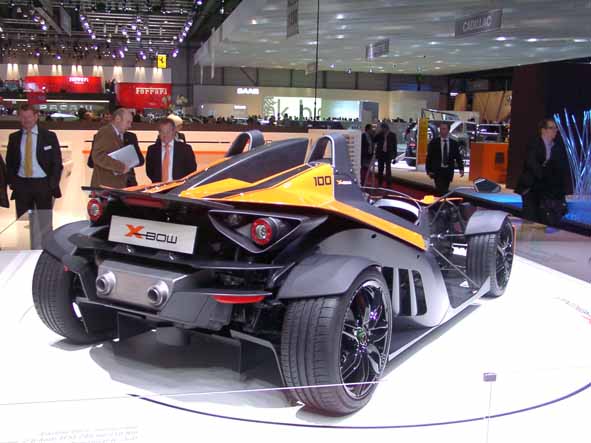
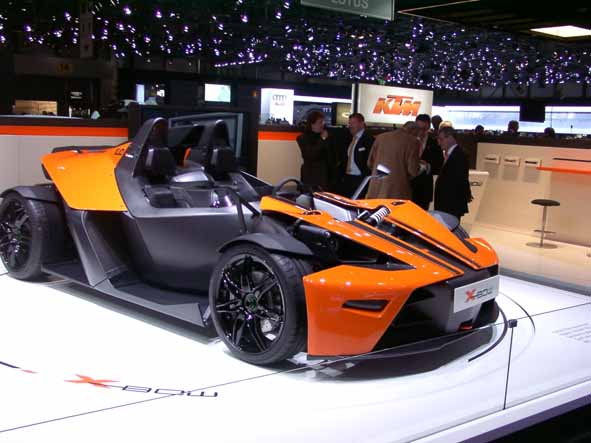
» Exhibited at Geneva in limited-edition ‘KTM X-Bow Dallara’ form
» Aggression and purity of original concept retained
» Carbon fibre monocoque is unique feature
» 240 bhp 2-litre Audi TFSI engine for spectacular performance
» True open car driving experience without roof or windshield
» Start of production set for mid-2008
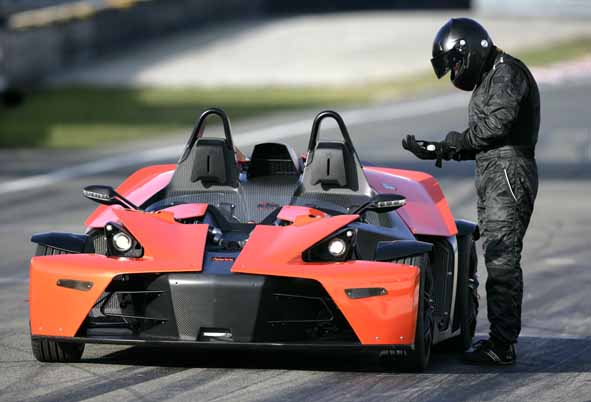
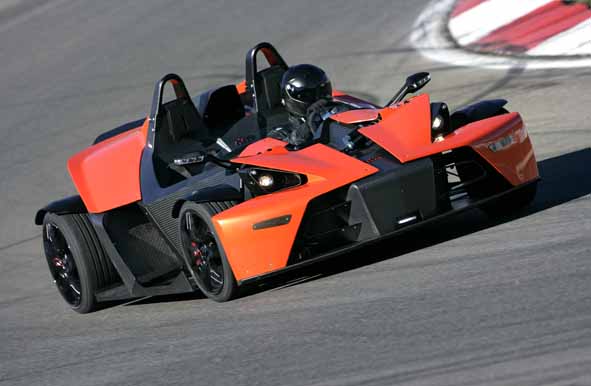
The KTM X-Bow: A Success Story
The motorcycle specialist manufacturer KTM celebrated the world premiere of its
first-ever car at the Geneva Motor Show in 2007 when the X-Bow was born. The
company sounded out the exclusive lightweight sports car market with an aggressive
design and a spectacular concept, complete with carbon fibre monocoque and purist,
minimalist fittings.
Following an overwhelmingly positive response from sports car enthusiasts and
motoring media all around the world, the decision was made to go ahead with further
development for the series production model of the KTM X-Bow.
Now, on the anniversary of that world premiere, KTM exhibits the results of the
continued development, showing the production-ready version of the KTM X-Bow for
the first time and in the exclusive form of the ‘X-Bow Dallara’ which will be a limitededition
of just 100 units.
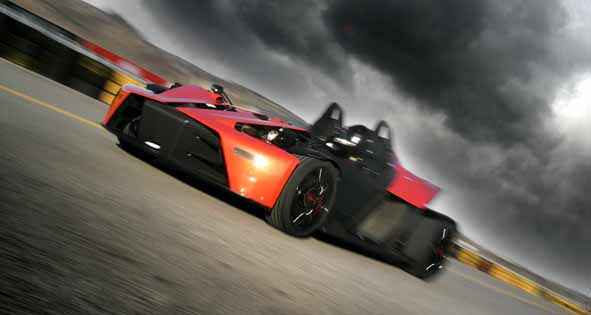
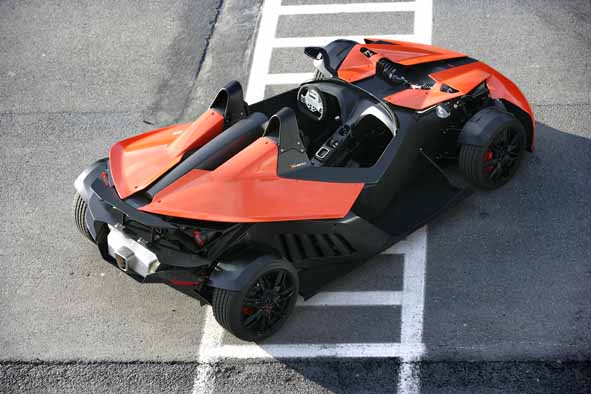
It says a lot about the dedication of the KTM engineers and testifies that the concept
was so ‘right’, that the series production model unveiled at Geneva stage looks so
similar to the original car. The original character of the KTM X-Bow is not watered
down with only a few concessions to meet technical, legal and practical
requirements. The central inlet to the air box is higher and larger and alterations to
the instrument panel are the most noticeable changes.
The original spirit of the KTM X-Bow is retained and it is still ‘ready to race’. The first
series production vehicles for customers will be seen on the road in the late summer
of 2008.
Radical and Avant-garde: The Concept
The most outstanding technical feature of the KTM X-Bow is its carbon fibre
monocoque. This avant-garde material and construction technique has been highly
developed for use in Formula 1, racing cars and expensive exotic sports cars for the
road. Its use by KTM places the X-Box in a privileged position among a small, but
elite group of radical lightweight sports cars.
This monocoque, which is manufactured by the specialist Wethje in Southern
Germany, incorporates a crash box at the front and a solid sandwich structured
floorpan and creates a structure that delivers safety without compromise. At the
same time the sophisticated carbon fibre material is also the key to the vehicle’s
status as a lightweight sports car. The KTM X-Bow weighs just 721 kilos.
The monocoque was developed together with the Italian racing and sports car
specialist Dallara (in whose honour the first 100 limited-edition cars are named). The
Italian company also assisted with the development and tuning of the chassis, which
will be offered in two configurations. In the series production model, the chassis
comes with a double wishbone and push rod suspension at the front.
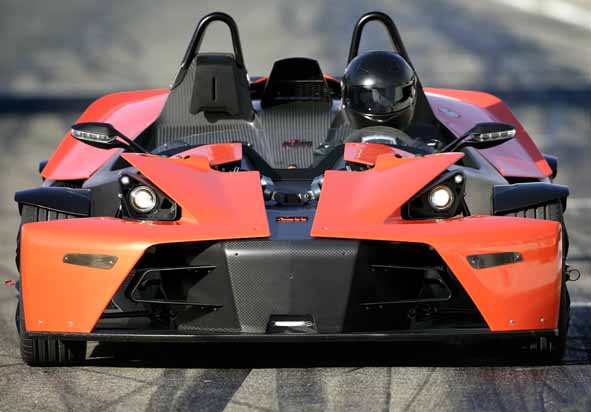
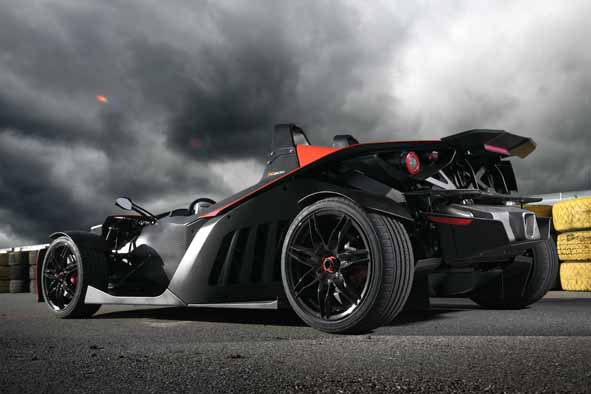
As an optional extra, KTM can supply the X-Bow with a motor racing chassis, which
features altered suspension geometry and settings and is also fitted with a pre-load
adjuster so that the clearance of the vehicle can be varied. On this chassis version,
the shock absorber elements from WP are adjustable in both rebound- and
compression damping.
The production KTM X-Bow is powered by a lightweight, compact, high performance,
high efficiency 2-litre Audi TFSI engine that is the perfect complement to the car’s
character. In contrast to the original concept the Audi engine now boasts a 177 kW
(240 bhp) output, with maximum torque of 310 Nm. The KTM comes with a sixspeed
manual transmission with close-set ratios. Thanks to its low weight the KTM
X-Bow can exceed the performance of many supercars that are twice as powerful. It
can accelerate to 100 kph in just 3.9 seconds.
With its radical concept, supercar performance, immensely capable chassis and
aerodynamics that have been purposefully tuned to generate downforce, the KTM XBow
is the perfect car for the racing circuit – as well as the road.
The KTM X-Bow, with its advanced technology and radical technical solutions is
directed at enthusiasts who are seeking a genuine, unfiltered driving experience.
To ensure that it is a road-legal car, KTM has already certified the X-Bow for use in
most European countries. With the general ratification of the new ‘European Small
Series Homologation’ regulations scheduled for first quarter of 2009, the road-legal
status will be extended to include all the countries of the European Union. Further
export markets are constantly being examined.
Concept and Series: The difference is in the detail
Because weight kills performance and mars the driving experience many traditional
comfort and convenience features were not present in the original KTM X-Bow
concept car. Radical construction without a roof or conventional windshield, and
doing without air-conditioning and an entertainment system, allow a sharp focus to be
kept on delivering the kind of driving experience that can usually be found only on a
motorcycle.
Now, KTM has not wavered from its original goals and only very small modifications
differentiate the prototype exhibited at the Geneva in 2007 from the production model
exhibited in 2008.
The most obvious change is the enlargement of the central air intake between the
headrests to ensure adequate cooling for the engine compartment during demanding
track-day activities.
The new arrangement of the instruments is a more marked change. Originally KTM
had positioned the indicator and control elements on the steering wheel. However
comprehensive testing showed that the readability of the instruments on the steering
wheel was not ideal. So, it was decided to create a display with the most important
information at the top of the centre console – the instruments echoing the style of
those recently presented on the new KTM RC8 superbike. This compact, lightweight
instrument panel is shower- proof and in the best racing tradition, the lighting system
controls remain on the sports steering wheel.
Also new are the side windows, the even smaller windshield (now made from
polycarbonate) and the new seating upholstery, which has been conceived and made
by a renowned specialist. Because the seat shells are made of carbon and rigidly
fixed to the monocoque the cushioning is available in a variety of sizes to suit drivers
of different statures. A mechanically adjustable pedal box ensures that drivers can
set-up a comfortable driving position with perfect ergonomics.
At the rear of the X-Bow, the silencer now comes with two exhaust pipes which allow
finer tuning of the exhaust sound for a more sporty sound.
The KTM X-Bow Dallara: the limited-edition beauty
At Geneva, KTM exhibits the series production X-Bow in its most elite form – the
special limited-edition X-Bow Dallara model. KTM will celebrate the start of
production in the middle of 2008 by producing just 100 examples of this version.
These future collectors’ models have been sold out for more than a year.
The fascinating X-Bow Dallara differs strongly both optically and technically from the
production model that follows because it incorporates ‘as standard’ most of the
factory-fitted options which will be offered on lesser versions.
For example, the bodywork comes in carbon (rather than plastic), the wheels have a
quick release/quick locking mechanism, the racing chassis comes with adjustable
suspension and the steering wheel is removable. A mechanical limited slip
differential improves traction and stabilises the vehicle during extreme manoeuvres.
Cosmetic design, aerodynamic, performance parts and wheel mudguards also
feature carbon finish. Special graphics are maintained in this special series, a metal
plaque in the interior presents the serial number of the automotive work of art.
The Extras: for the Automobile and the Driver
For those X-Bow enthusiasts who weren’t lucky enough to be among the first 100
‘Dallara-series’ customers, the standard production model KTM X-Bow is available
with the choice of many of the optional extras found on the limited Dallara edition.
Aside from the special graphics and Dallara plaque, it is possible to order all other
extras from the Dallara series model for the production car.
KTM’s recently-launched ‘Car Configurator’ system allows prospective buyers to view
and specify the full range of extra equipment for their vehicle. Accessible through the
KTM X-Bow website, at www.ktm-x-bow.com, the easy-to-use software gives a clear
breakdown of the options available.
While European authorities permit driving the X-Bow without a helmet, KTM strongly
recommends wearing a helmet and will present two options – developed exclusively
for X-Bow – at the Geneva Show. The Arai closed racing helmet provides
comprehensive protection and meets the requirements of the motor sports
authorities. An open face helmet, manufactured by German company Schuberth is
also offered to give better peripheral vision when driving X-Bow on the road. Both
helmets carry X-Bow branding and will be available when the series production
models go onto the market. A range of clothing and technical accessories for the
driver are also in development.
Production and Aftersales: slim and efficient
Following the hugely positive response to the introduction of X-Bow and growing
demand for KTM’s new quad bikes, which have recently been introduced in the USA,
KTM has decided that production of X-Bow will not be outsourced, as originally
anticipated. Instead, KTM has established a new assembly facility specifically for the
production of its four-wheel products, near Graz in Austria.
The manufacture of the KTM X-Bow will create around new 50 jobs, as KTM
produces 500 units in 2008, before the production expands to a maximum capacity of
1000 units annually, when the facility is fully operational.
KTM is in the process of finalising its network of specialist service partners to meet
the aftersales requirements the X-Bow customers. When all agreements have been
finalised, KTM plans to have a Europe-wide network of approximately 50 X-Bow
service centres.
Delivery of cars is organised through the company headquarters in Mattighofen.
Customers will be given the option of collecting their vehicle at their nearest service
centre – or to have their new KTM X-Bow personally delivered to their door.
The Next Step: Visions for Tomorrow
While making the final preparations for the start of series production and the
expansion of the service network, KTM is also planning to introduce the X-Bow onto
the racing circuit. A racing model for this purpose is in development and the X-Bow
will make its first public appearance on the race circuit during 2008. In the longerterm,
KTM is considering the organization of a one-make series competition for XBow.
There are also further updates planned for the X-Bow itself in the future. A raceengineered
version, which will increase power into the region of 300 bhp, is expected
at a later date. The car will also be offered with an optional S tronic sequential
double clutch semi-automatic gearbox.
----------------------------------------------------------------------------------
The KTM X-Bow: highlights in detail
Carbon Fibre Monocoque: Racing Equipment for the Road
Carbon fibre monocoques have been Formula 1’s safety net for many years. On the
road, this technology has always been reserved for the elite supercars in the highest
price ranges. KTM is proud to be the first company to offer this chassis technology in
a much more affordable form, and has called upon the expertise of its development
partners for this project, Dallara, and carbon fibre specialists Wethje Group, to make
X-Bow a reality.
The Italian specialist from Varano Melegari, near Parma, Dallara has long been
acclaimed as a carbon technology expert from the conception and design through to
the production of components made of this light, yet rigid material. Dallara currently
supplies the monocoque race-car chassis for international formula such as GP2, Indy
Car (IRL) and Formula 3.
KTM has also been able to utilise the expertise of Wethje Group to manufacture the
carbon fibre monocoque for the X-Bow. Widely considered as one of the most
experienced specialists for carbon composite construction components, Wethje is a
successful supplier to premium segment car manufacturers, as well as to Formula 1
and touring car teams.
The monocoque developed for the KTM X-Bow is not only extremely robust, it is also
safe, thanks to an integrated crashbox in the nose, and yet it weighs only 75 kilos.
This low weight is a crucial factor in ensuring the vehicle’s spectacular performance.
The Engine: TFSI Technology from Audi
To power the X-Bow, KTM was delighted to form a partnership with Audi AG for
developing the drive unit. Audi’s 2.0-litre four-cylinder TFSI engine reflects the XBow’s
construction principles by featuring lightweight, high-performance and
intelligent technologies.
The engine’s outstanding attribute is its gasoline direct injection technology, FSI. For
its KTM X-Bow application, the engine also boasts an exhaust turbocharger plus an
intercooler. Thanks to FSI technology, this engine utilizes fuel more efficiently than
one with ordinary intake manifold injection and it even consumes less fuel in the
frequently used partial load range.
With FSI technology, the fuel injection takes place at a pressure level between 30
and 110 bar. Valves in the intake system direct the inflowing air into a cylindrical
movement, and a continuously variable intake camshaft ensures optimal cylinder
charging at any engine speed. Two counter-rotating balancer shafts compensate the
second order inertia forces and so guarantee superior, low-vibration operation.
The KTM X-Bow’s long-stroke, four-valves per cylinder Audi engine delivers powerful
performance with 300 Nm of torque between 2200 and 4000 rpm, while peak power
(177 kW / 240 bhp) is achieved at 6000 rpm. Even more powerful engine variations
in the 300-horsepower range are planned for the X-Bow in the future.
The transversely-mounted engine and drive train package is complemented by a VWsourced
six-speed manual transmission as standard. Drive goes to the rear wheels
via an optional mechanical limited-slip differential. An optional S-tronic semiautomatic
transmission will also be offered at a later date.
The Chassis: Direct and Competent
The X-Bow’s driving dynamics benefit from the car’s low centre of gravity, the sporty
bias to its front/rear weight distribution and its superior chassis, which draws on
racing technology for its basic principles. The relatively long wheelbase (2430 mm)
and wide track (1644 mm front, 1624 mm rear) provide the foundations for a
comfortable ride and excellent stability.
Employing double wishbones, front and rear, the suspension features components
and damping elements by WP Suspension, with a pushrod arrangement up front.
Available with a choice of ‘Sport’ or ‘Racing’ set-up, the chassis can be biased for
road or track use respectively. While both options can be adjusted for traction and
pressure settings, the Dallara-designed ‘Racing’ configuration is fitted with a pre-load
adjuster for adjustment of the vehicle’s ground clearance.
KTM is also expanding its partnership with the famous Italian brake manufacturer
Brembo into the world of automobiles. The X-Bow’s immensely powerful braking
system consists of 305 mm ventilated discs with 4-piston fixed callipers at the front
and 262 mm solid discs with 2-piston fixed callipers at the rear. The combination of
the vehicle’s light weight, ideal balance, low centre of gravity and high-performance
Continental tyres – 205/40 R17 front and 235/40 R18 rear – results in spectacular
braking performance. When the brakes are warm, the KTM X-Bow needs only 33.1
metres to decelerate from 100 kph to a standstill.
The Aerodynamics: Exceptional Contact Pressure
The primary development goal for the KTM X-Bow was not attaining extremely high
top speeds, but in optimising its driving dynamics. The sports car’s performance is
aided by an ingenious aerodynamics arrangement – the result of many hours work in
Dallara’s wind tunnel. The most important aero element is the underbody, which is
equipped with a prominent diffusor at the rear. To make this diffusor work even more
effectively, the mounting points for the rear suspension were set as high as possible.
This enables the KTM X-Bow to achieve a phenomenal downforce of almost 50 kg at
100 km/h and nearly 200 kg at a speed of 200 km/h – approximately three times
more than most other supercars.
The high-performance chassis plus this fantastic level of downforce makes extreme
cornering speeds possible. The X-Bow can generate a lateral acceleration of 1.0 g in
a 30-metre radius corner, and up to 1.23 g around a 200-metre radius bend. These
g-forces and cornering speeds comfortably surpass the values achieved by most
street-legal sports cars.
The aerodynamic concept posed a great challenge for the designers. They had to
ensure that sufficient engine-cooling air could be channelled into the inlets located in
the sides of the vehicle, behind the passengers, while not upsetting the aero-balance
or the generation of downforce. This challenge was accomplished by using special
air baffles, which are installed horizontally on the sides of the car so that the driver
and passenger can also use them as boarding aids. The radiator is also located at
the rear of the vehicle, to avoid having to install longer, heavier water hoses.
Safety: Racing Technology
The crucial component protecting the driver and the passenger is the rigid, carbon
fibre monocoque – safety technology straight from the world of professional motor
racing. This structure is supplemented by a crashbox in the nose of the vehicle,
which fulfils stringent FIA Formula 3 safety requirements. At the rear of the car, the
exhaust silencer is also designed to act as a crashbox; absorbing the force of an
impact to the rear of the vehicle.
The driver and passenger are protected by four-point safety belts, which can be
equipped with a fifth securing point (a crutch strap) as an option. Twin roll bars are a
distinctive feature of the X-Bow’s striking appearance. They not only look solid, they
are skilfully integrated into the monocoque’s structure to offer the highest level of
safety.
Design: Floating Elements
Gerald Kiska’s design studio can take credit for the shape of the X-Bow. Coming
from Salzburg, Kiska has worked closely with KTM for the past 15 years and has
been entrusted not only with the design of the motorcycles, but also with the
appearance of the company itself.
For the concept of KTM’s first automobile, Kiska incorporated many characteristics
that are more closely associated with motorcycles than cars. Every part of the 3.67-
metre long X-Bow fulfils a function, the technology remains transparent, the form is
noticeably simple. The few, orange-coloured body panels are ‘floating elements’, like
those of motorcycles, and suggest lightness and simplicity.
The deliberate minimalism is applied to all things, even the lights: simple headlamps,
embedded indicators flush with the car’s contours and round lights at the rear, avoid
superficial, showy effects. Instead, the functional carbon structure also takes on
design duties, meaning that components which are frequently hidden in cars, such as
the silencer, suddenly serve an aesthetic purpose in addition to their usual functions.
The Equipment: Pure and Functional
As a result of its strong, clear concept, the KTM X-Bow can do without a lot of
elements that ordinarily add complexity and extra weight to cars. For example, the
narrow wind deflector makes an elaborate heating system and windscreen wipers
unnecessary; doors are also not included in the design, due to the vehicle’s low
profile and the extra-low side profile which makes for easy access.
Drivers will also search in vain for a standard instrument panel. All the information
needed for driving is presented in the multi-functional display on the steering wheel.
The seats are further examples of the X-Bow’s intelligent and simple construction.
The shells for the driver’s and passenger’s seats are already integrated into the
carbon fibre construction of the monocoque, in a fixed position. An overlay provides
firm support and comfort. In order to provide the best ergonomics for drivers of
various heights, the X-Bow has manually adjustable pedals.
The KTM X-Bow doesn’t have a luggage compartment, but instead features an
innovative, mobile storage box for the car documents. The equipment required by
law, such as a warning triangle, first aid kit and a tyre-repair system, are carried in
storage compartments beside the passenger’s foot well. A cover to protect the
interior of the car when parked is stowed in the same location. Two helmets can be
fixed in the passenger’s foot well.
















 History of "Menu dei Motori"
History of "Menu dei Motori"

 DESIGN PROJECT
DESIGN PROJECT UNIVERSITA' DI MODENA
UNIVERSITA' DI MODENA








Comments
Nessun commento presente
Add Comment